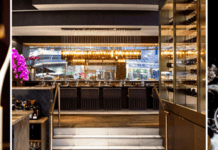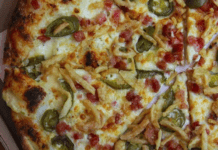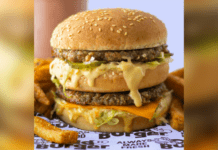THE CHALLENGE
A decade ago, a ‘grocerant’ — a hybrid grocery/restaurant offering — was rare and the concept of grocery delivery and meal kits was almost unheard of. Today, the global meal-kit market is estimated at approximately $2.2 billion, according to Time magazine, and grocerants represent approximately four per cent of total commercial foodservice dollars (six per cent of total visits) according to Toronto-based NPD Group.
Billy Arvanitis is vice-president of Operations at Foodtastic, but his industry experience spans decades. He says at the beginning of the food-retail uprising, there was a common concern.
“Initially, when [grocery stores] introduced our core products, there was a lot of fear, wondering if the two would ever intersect or if would we cannibalize our own market.”
There are four pillars linked to the success of both meal kits and grocerants: flexibility of offerings, freshness of products, the experience factor and convenience.
But Vince Sgabellone, foodservice analyst at NPD Group, says one pillar trumps them all. “Convenience. People who are buying food through grocerants are time strapped, so it’s all [about making it] quick and easy,” says Sgabellone. “They’ve found a niche for themselves between QSR and FSR — full-service quality with quick-service convenience.”
This convenience applies not only to customers grabbing a quick bite to eat in grocerants while doing their weekly grocery shopping, it also extends beyond the supermarket.
Meal kits provide the much-needed convenience, with the added luxury of not having to leave your house — a key factor helping the segment steal share from restaurants, says Sgabellone.
“One third of all meal-kit customers [we surveyed] said they would have purchased food from a restaurant that night had they not had a meal kit,” says Sgabellone.
George Bachoumis is the general manager of The McEwan Group — the largest independent grocerant in Canada — and has worked in the foodservice industry for more than 30 years. He says while convenience plays a role, the real driving force behind the success of grocerants is their flexibility and freshness.
“Our chefs will come down to the grocery level, shop all the fresh ingredients they need and then bring them to the [in-house] restaurant and create these dishes,” says Bachoumis. “There’s variety — within our space we have Asian-inspired, Indian-inspired and Mediterranean — whereas restaurants are limited in what they can offer. Every customer that comes into our store has a different need and the added flexibility of being a hybrid store allows us to meet most of those needs, with chef-inspired foods.”
This freshness and quality of food is another reason why Sgabellone thinks we saw a sudden rise in grocerant traffic a few years ago.
“Grocery stores have been upping their game in terms of quality, breadth and types of offerings. It was no longer just convenient, it was good. It was restaurant-quality food that you could grab at the grocery store,” he says.
According to Jessica Rodrigues, director of Communications at The McEwan Group, the next logical step for grocerants is to expand into the event sector.
“Instead of having a Christmas dinner at a restaurant, you come to a hybrid like McEwan and have that sit-down meal, but also get cooking demos and a shopping night with discounts,” says Rodrigues.
It’s these after-hours events that pose a real challenge to restaurants, many of which lack the space to host them. And, while most holiday parties start at a restaurant and conclude elsewhere, grocerants are able to accommodate the entire event.
Ennio Perrone, vice-president of Marketing and Business Strategy at Eataly, a European grocerant concept that recently entered Toronto, cites customer experience as a reason for the brand’s success.
“Being able to create an experience where guests can eat, shop and learn about authentic Italian ingredients and regional Italian dishes has been an important part of every Eataly location since we opened our first location in Torino 13 years ago,” says Perrone. “Moving from a purely transactional food-retailer model of products stacked on shelves to offering the opportunity for customers to experience more — to see the food they’re buying being turned into delicious dishes in the hands of experienced chefs, in a space where they feel comfortable and can learn and do new exciting things in every visit while having fun — are fundamental pillars,” says Perrone.
THE OPPORTUNITY
While the challenges arising from food-retail competition have caused some restaurateurs to lose sleep, the sky is not falling just yet.
NPD Group reports growth of the meal-kit and grocerant segments has slowed in the past few years. “[The segments] were trending up in 2016 to 2017, but the last two years it’s flat lined a bit,” says Sgabellone.
This has created new opportunities for restaurants, such as branded meal kits — a partnership between meal-kit-delivery programs and restaurants — or advanced restaurant loyalty programs that reach beyond the traditional coffee shop to larger chains.
Branding products seems to be the biggest opportunity for restaurants looking to combat the rise of retail, as Arvanitis puts it, “if you can’t beat them, brand them.”
“Marketing dollars are stretched very thin, so when I see branded product in stores readily available, it creates a lot of brand awareness,” says Arvanitis. “When it’s done responsibly, it’s a good marriage.”
And, while a study conducted by NPD Group and Nielsen showed 38 per cent of surveyed Canadians had purchased some type of meal kit for dinner in the past year, attracted by the convenience of the offering, delivery — the great equalizer — is now giving restaurant operators a leg up on the competition. Whether through a third-party or in-house, delivery systems are the Achilles heel of the meal-kit and grocerant segments, says Sgabellone.
“What’s easier than a few taps on your phone and ordering delivery to your door? Delivery has taken away some of that convenience aspect that was the calling card of grocerants,” he explains.
“If you’re not on board with delivery services, you’re missing the boat. That’s the way we’re trending. Whether its mobile apps or other players, it’s here to stay,” adds Arvanitis.
But, Sgabellone warns, restaurants walk a fine line between sticking with what they know and evolving to keep up with the competition. “Focusing on your core customer is key — who they are and why they’re coming to you. Stand out in the market, do what’s best for your customers. If you’re not speaking to your customers, somebody else will.”
“A brand needs to embark on new trends when it makes sense for their brand to do so. Eataly shines in the store, where you get to live the experience in its entirety. That’s the entry point for people to get to know and interact with our brand,” says Perrone.
“You have to keep evolving, because everyone else around you is changing all the time,” adds Bachoumis.
Looking forward, the market will continue to evolve and, when it does, operators on both sides of the coin need to be ready to collaborate or be left by the wayside.

















